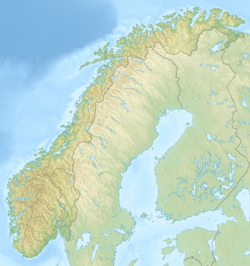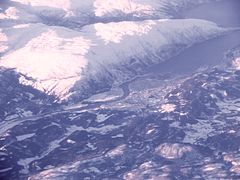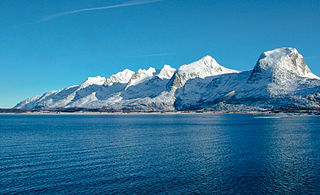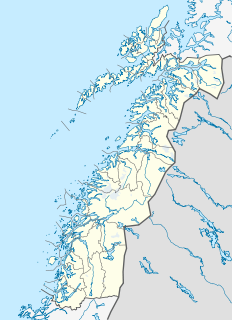| Vefsnfjorden Vefsnfjord | |
|---|---|
 View of the fjord | |
| Location | Nordland county, Norway |
| Coordinates | 65°54′17″N12°36′38″E / 65.9047°N 12.6106°E Coordinates: 65°54′17″N12°36′38″E / 65.9047°N 12.6106°E |
| Type | Fjord |
| Basin countries | Norway |
| Max. length | 51 kilometres (32 mi) |
| Max. depth | 440 metres (1,440 ft) |
| Settlements | Mosjøen |
The Vefsnfjord or Vefsnfjorden is a fjord in the Helgeland traditional district of Nordland county, Norway. It is about 51 kilometres (32 mi) long, reaching a maximum depth of about 440 metres (1,440 ft) below sea level. The fjord flows through the municipalities of Alstahaug, Leirfjord, and Vefsn.

Geologically, a fjord or fiord is a long, narrow inlet with steep sides or cliffs, created by a glacier. There are many fjords on the coasts of Alaska, Antarctica, British Columbia, Chile, Greenland, the Faroe Islands, Iceland, Kamchatka, the Kerguelen Islands, New Zealand, Norway, Novaya Zemlya, Labrador, Nunavut, Newfoundland, Quebec, Scotland, South Georgia Island, and Washington state. Norway's coastline is estimated at 29,000 kilometres (18,000 mi) with nearly 1,200 fjords, but only 2,500 kilometres (1,600 mi) when fjords are excluded.

Helgeland is the most southerly district in Northern Norway. Generally speaking, Helgeland refers to the part of Nordland county that is located south of the Arctic Circle. It is bordered in the north by the Saltfjellet mountains and Svartisen glacier, which form a natural border with the Salten district. In the south, Helgeland borders Trøndelag county.
The country Norway is historically divided into a number of districts. Many districts have deep historical roots, and only partially coincide with today's administrative units of counties and municipalities. The districts are defined by geographical features, often valleys, mountain ranges, fjords, plains, or coastlines, or combinations of the above. Many such regions were petty kingdoms up to the early Viking age.
Contents
The fjord begins at Tjøtta, south of the island of Alsten and meets the Leirfjord at the island of Sundøy before turning to the south as it proceeds inland to the town of Mosjøen. The outer part of the fjord is also called Sørfjord. [1]

Tjøtta is an island in Alstahaug Municipality in Nordland county, Norway. The 11.3-square-kilometre (4.4 sq mi) island lies at the entrance to the Vefsnfjorden, just south of the island of Alsta. The U-shaped island is relatively flat, and the highest point is the 77-metre (253 ft) tall Kalvberghaugen, just east of the village of Tjøtta. The island has two main villages on it: Tjøtta and Svinnes. The Norwegian County Road 17 crosses the island and it connects it to the neighboring islands of Offersøya and Alsta by two causeways.
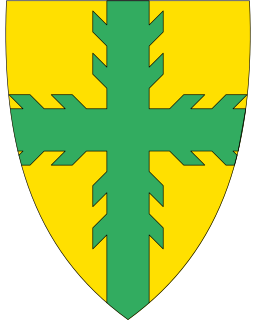
Leirfjord is a municipality in Nordland county, Norway. It is part of the Helgeland traditional region. The administrative centre of the municipality is the village of Leland. Other villages in Leirfjord include Bardalssjøen and Sundøy. The large Helgeland Bridge is partly located in the municipality, connecting it to Alstahaug Municipality and the town of Sandnessjøen.
Several large rivers run into the Vefsnfjord, including the Vefsna, Fusta, and Drevja. All three of the rivers are traditionally excellent salmon fishing rivers, although they now have been infected with the salmon parasite Gyrodactylus salaris.

Vefsna (Norwegian), also known as Vaapstenjeanoe (Southern Sami) or Vapstälven (Swedish), is the largest river in Nordland county, Norway. It is 163 kilometres (101 mi) long and drains a watershed of 4,122 square kilometres (1,592 sq mi). Its headwaters lie in the mountains of Børgefjell National Park at the lake Simskardvatnet. The river runs through the municipalities of Hattfjelldal, Grane, and Vefsn. The southern parts of the river are sometimes called the river Susna. The river flows north, not far from the Swedish border, and some of the minor tributaries come from Sweden. At the town of Mosjøen, the river discharges into the Vefsnfjord. The Laksforsen waterfall lies along its course.

Salmon is the common name for several species of ray-finned fish in the family Salmonidae. Other fish in the same family include trout, char, grayling and whitefish. Salmon are native to tributaries of the North Atlantic and Pacific Ocean. Many species of salmon have been introduced into non-native environments such as the Great Lakes of North America and Patagonia in South America. Salmon are intensively farmed in many parts of the world.

Gyrodactylus salaris, commonly known as salmon fluke, is a tiny monogenean ectoparasite which lives on the body surface of freshwater fish. This leech-like parasite has been implicated in the reduction of Atlantic salmon populations in the Norwegian fjords. It also parasitises other species, including rainbow trout. G. salaris requires fresh water, but can survive in brackish water for up to 18 hours.
A German prisoner ship was sunk here by British Aircraft during World War II with major loss of life. A memorial is located on a nearby island.

World War II, also known as the Second World War, was a global war that lasted from 1939 to 1945. The vast majority of the world's countries—including all the great powers—eventually formed two opposing military alliances: the Allies and the Axis. A state of total war emerged, directly involving more than 100 million people from over 30 countries. The major participants threw their entire economic, industrial, and scientific capabilities behind the war effort, blurring the distinction between civilian and military resources. World War II was the deadliest conflict in human history, marked by 50 to 85 million fatalities, most of whom were civilians in the Soviet Union and China. It included massacres, the genocide of the Holocaust, strategic bombing, premeditated death from starvation and disease, and the only use of nuclear weapons in war.
A powerline crosses Vefsnfjord near Overtroan with a 3.236-kilometre (2.011 mi) long span.

